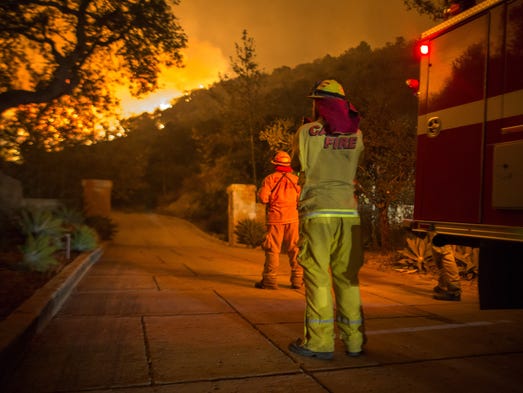VENTURA, Calif. — A Cal Fire engineer died Thursday while battling the Thomas fire in steep terrain in the hills outside Fillmore, officials said.
Chief Ken Pimlott, director of the Department of Forestry and Fire Protection, confirmed the firefighter's death in a news release. The Ventura County Fire Department identified him as Cory Iverson.
"I am very saddened to report that a firefighter fatality has occurred on the Thomas incident. The incident is still unfolding, but in this world of fast-moving information, it is important to me that only factual information be shared. To that end, I can confirm a fatality of a Cal Fire engineer from the San Diego Unit has occurred," Pimlott said.
The firefighter's family was notified, Cal Fire officials said.
By 2 p.m., a hearse and an investigator with the Ventura County Medical Examiner's Office arrived at the scene. The firefighter died about 9:30 a.m. PT about a mile or so off Grand Avenue, authorities said.
A Ventura County helicopter was called about the same time to a report of an injured firefighter but was called off shortly thereafter, officials said.
A Cal Fire engineer died near Fillmore on the 11th Day of the Thomas Fire. Steve Byerly
The firefighter's death is the second confirmed fatality linked to the Thomas fire. Virginia Pesola, 70, of Santa Paula, was found dead last week at the site of a car accident on Wheeler Canyon Road, which was under a mandatory evacuation order.
Since the blaze started near Santa Paula on Dec. 4, Santa Ana winds have helped it spread. It has burned more than 242,500 acres, making it California fourth-largest recorded wildfire, unseating the Zaca fire, which scorched 240,207 acres.
More than 8,100 fire personnel have taken part in fighting the massive Thomas fire, which crossed into Santa Barbara County earlier this week.
Although Santa Ana winds have come and gone during the fire, they started picking up again by early Thursday. Officials said flare-ups were expected in the Fillmore and Sespe wilderness areas, which forecasters say is directly associated with the winds.
Stuart Seto, a meteorologist with the National Weather Service in Oxnard, said gusts up to 60 mph have been reported.
"This is having a big effect on the fire because it's blowing the embers and everything down the road," Seto said.
There have also been reports of a flare-up in the Rose Valley area north of the Ojai Valley in Los Padres National Forest. Gusts there were between 40 and 50 mph, Seto said.
Windy conditions mean danger for firefighters, the meteorologist said. The winds were expected to continue into Friday morning. A red-flag fire warning has been issued until then, Seto said.
In Santa Barbara County, where the main front of the fire is in the Carpinteria and Montecito areas, a different type of wind could pose challenges. Sundowner winds, which move northerly offshore, are expected Friday.
According to the Ventura County Fire Department, full containment of the Thomas fire may be achieved by Jan. 7 — more than three weeks from now.
Thirty percent had been contained as of Thursday and authorities expect flames to continue spreading for the foreseeable future. The bulk of resources are focused on the southern perimeter near the populated areas, leaving the north, east and west perimeters unobstructed and open to growth.
"There are still areas of concern, mostly in Santa Barbara County, but also on the eastern flank," Buschow said. "It's kind of north of Fillmore where we're seeing increased fire activity."
As of Thursday, the Thomas fire had destroyed 972 buildings in Ventura and Santa Barbara counties.
The Zaca fire destroyed one building and there were no fatalities.
Similarly, there were no fatalities during the second- and third-worst wildfires in California history: The August 2012 Rush fire and the August 2013 Rim fire, respectively.
Lightning sparked the Rush fire and flames burned 271,911 acres in Lassen County in Northern California. The Rim fire, which was human-caused, burned 257,314 acres in Tuolumne County and destroyed 112 buildings.
California's largest wildfire on record is the 2003 Cedar fire, which burned 273,246 acres in San Diego County. Fifteen people died and 2,820 buildings were destroyed.
October's Tubbs fire in Sonoma County became the most destructive fire in state history after it destroyed 5,643 buildings in Northern California's wine country. It burned 36,807 acres and killed 22 people.
The deadliest blaze was the Griffith Park fire in October 1933. The Los Angeles County fire left 29 people dead, burned 47 acres and damaged no buildings.
Contributing: Colin Atagi, The (Palm Springs, Calif.) Desert Sun. Follow the Ventura County (Calif.) Star on Twitter: @vcstar



